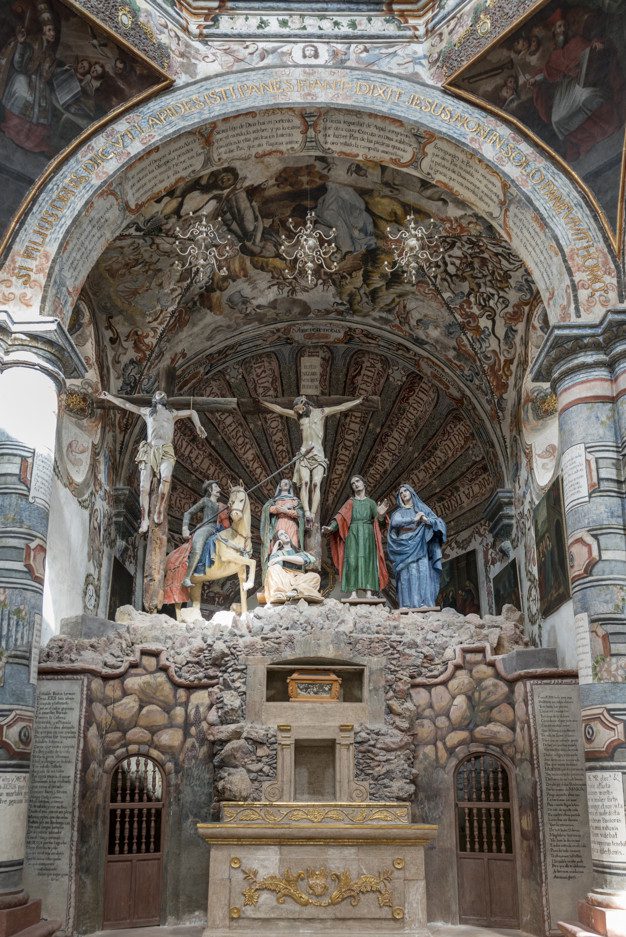UNESCO: Protectd town of San Miguel and the Sanctuary of Jesús Nazareno de Atotonilco

The fortified town, first established in the 16th century to protect the Royal Route inland, reached its apogee in the 18th century when many of its outstanding religious and civic buildings were built in the style of the Mexican Baroque. Some of these buildings are masterpieces of the style that evolved in the transition from Baroque to neoclassical. Situated 14 km from the town, the Jesuit sanctuary, also dating from the 18th century, is one of the finest examples of Baroque art and architecture in the New Spain. It consists of a large church, and several smaller chapels, all decorated with oil paintings by Rodriguez Juárez and mural paintings by Miguel Antonio Martínez de Pocasangre. Because of its location, San Miguel de Allende acted as a melting pot where Spaniards, Creoles and Amerindians exchanged cultural influences while the Sanctuary of Jesús Nazareno de Atotonilco constitutes an exceptional example of the exchange between European and Latin American cultures. Its architecture and interior decoration testify to the influence of Saint Ignacio de Loyola’s doctrine.
San Miguel de Allende is an early example of a rational territorial and urban development in the Americas, related to the protection of one of the main Spanish inland roads. The town flourished in the 18th century with the construction of significant religious and civil architecture, which exhibits the evolution of different trends and styles, from Baroque to late 19th century Neo-Gothic. Urban mansions are exceptionally large and rich for a medium-size Latin American town and constitute an example of the transition from Baroque to Neo-Classic. The Sanctuary of Atotonilco is a remarkable architectural complex that illustrates a specific response, inspired by the doctrine of Saint Ignacio de Loyola. Its interior decoration, especially mural painting, makes the Sanctuary a masterpiece of Mexican Baroque. Both the town and the Sanctuary, intimately linked, played a significant role in the process of Mexican independence, with impacts throughout Latin America.
San Miguel de Allende constitutes an exceptional example of the interchange of human values; due to its location and functions, the town acted as a melting pot where Spaniards, Creoles and Amerindians exchanged cultural influences, something reflected in the tangible and intangible heritage. The Sanctuary of Jesús Nazareno de Atotonilco constitutes an exceptional example of the cultural exchange between European and Latin American cultures; the architectural disposition and interior decoration testify to the interpretation and adaptation of the doctrine of Saint Ignacio de Loyola to this specific regional context.
San Miguel de Allende is an exceptional example of the integration of different architectural trends and styles on the basis of a 16th century urban layout. Religious and civil architecture exhibit the evolution of different styles, well integrated into a homogeneous urban landscape. Urban mansions are exceptionally large and rich for a medium-size Latin American town. The Sanctuary of Atotonilco is an outstanding example of a specific religious settlement, containing exceptional decoration that makes it a masterpiece of Mexican Baroque.
The required conditions of integrity and authenticity have been met; both the town and Sanctuary have been subject to few significant alterations over time, urban changes have been adapted to the town’s features and scale, and restoration works have been carried out according to appropriate theoretical and technical principles.
The legal system in place ensures the adequate protection of the property and the town and the Sanctuary exhibit an acceptable state of conservation. Management policies, structures and plans in place are adequate to ensure the preservation of the property’s values, integrity and authenticity.
SOURCE: https://www.ovpm.org/city/san-miguel-de-allende-mexico/

